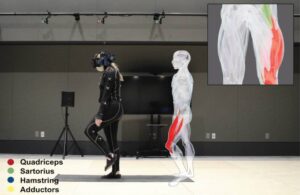
[Image from MIT]
MuscleRehab came from researchers at MIT’s Computer Science and Artificial Intelligence Laboratory (CSAIL) and Massachusetts General Hospital (MGH).
Together, they combined three ingredients: motion tracking, imaging and virtual reality (VR). The motion tracking captures motion activity. The electrical impedance tomography (EIT) imaging technique measures what muscles are doing. Finally, a VR headset and tracking suit lets users watch themselves perform alongside a physical therapist.
In a news release, MIT described its all-black tracking suit as “sleek” and “ninja-esque.” The VR captures 3D movement data. The user performs various exercises that measure the activity of their quadriceps, sartorius, hamstrings, and adductors.
The researchers provided two conditions in a virtual environment. Both featured exercise performance alongside a physical therapist. In the first situation, only motion tracking data overlays onto the patient avatar. In the second, the patient uses EIT sensing straps and they have all information for their motion and muscle engagement.
In comparing the exercise accuracy between both conditions, a professional therapist received the results and explained which muscle groups were supposed to be engaged during each of the exercises. By visualizing both muscle engagement and motion data instead of motion alone, the overall accuracy of exercises improved by 15%, MIT said.
The team also conducted a cross-comparison of how much time during the exercises the correct muscle group was triggered between the two conditions. By monitoring and recording most engagement data, physical therapists reported a “much better understanding” of the quality of the patient’s exercise. This helped to better evaluate their current regime and exercise based on the stats.
“We wanted our sensing scenario to not be limited to a clinical setting, to better enable data-driven unsupervised rehabilitation for athletes in injury recovery, patients currently in physical therapy, or those with physical limiting ailments, to ultimately see if we can assist with not only recovery, but perhaps prevention,” said Junyi Zhu, MIT CSAIL PhD student and lead author on a paper about MuscleRehab. “By actively measuring deep muscle engagement, we can observe if the data is abnormal compared to a patient’s baseline, to provide insight into the potential muscle trajectory.”
According to MIT, current sensing technologies mostly focus on tracking behaviors and heart rates. Zhu and the team aimed to find a better way to sense engagement in different layers of the muscles compared to electromyography (EMG). EMG only captures muscle activity right beneath the skin unless done invasively, MIT noted.
EIT, usually used for monitoring lung function, detecting chest tumors and diagnosing pulmonary embolism, hadn’t been used for this purpose before, Zhu found.
Now, the EIT sensing board serves as the “brains” behind the MuscleRehab system. Two straps filled with electrodes slip onto a user’s upper thigh to capture 3D volumetric data. Motion capturing, using OptiTrack, utilizes 39 markers and a handful of cameras to sense high frame rates per second. The data showed actively triggered muscles highlighted on the display, with a given muscle growing darker with more engagement.
Currently, MuscleRehab focuses on the upper thigh and the major muscle groups inside. The researchers aim to expand to the glutes.
“This work advances EIT, a sensing approach conventionally used in clinical settings, with an ingenious and unique combination with virtual reality,” said Yang Zhang, assistant professor in electrical & computer engineering, UCLA Samueli School of Engineering. “The enabled application that facilitates rehabilitation potentially has a wide impact across society to help patients conduct physical rehabilitation safely and effectively at home. Such tools to eliminate the need for clinical resources and personnel have long been needed for the lack of workforce in healthcare.”




